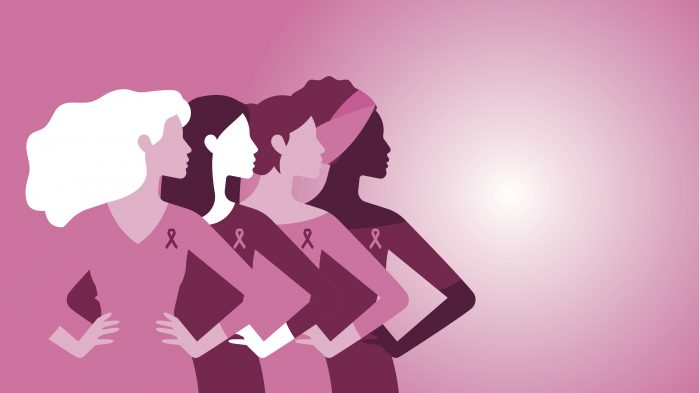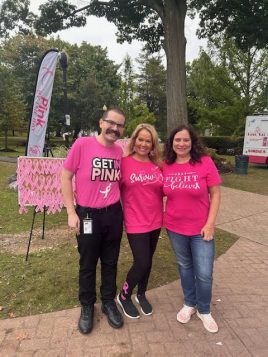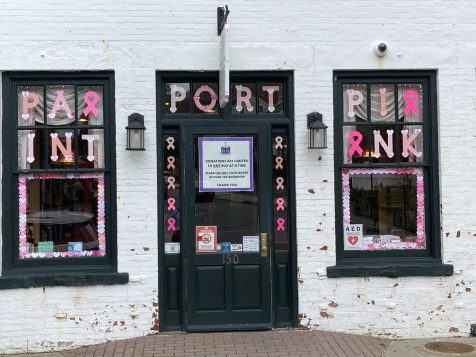Emphasis put on screening, diet and exercise
By David Dunaief, M.D.

Currently, approximately 30 percent of new cancer diagnoses in women are breast cancer (1). While age is a risk factor for breast cancer, 16 percent of 2024 diagnoses will be in women under age 50.
This October, for Breast Cancer Awareness month, let’s review the latest research on screening, treatments, and prevention strategies.
What are current screening recommendations?
In April 2024, the U.S. Preventive Services Task Force expanded their screening recommendations for women of average breast cancer risk. They lowered the recommended start point for mammograms to age 40, continuing every other year through age 74 (2).
The American College of Obstetricians and Gynecologists is reviewing their recommendations in light of this USPSTF shift. They currently encourage a process of shared decision-making between patient and physician to determine age and frequency of exams, including whether to begin exams before age 50 or to continue after age 75 (3). Generally, it recommends beginning annual or biennial mammograms starting no later than 50 and continuing until age 75.
The American Cancer Society’s physician guidelines are to offer a mammogram beginning at age 40 and recommend annual exams from 45 to 54. At age 55 until life expectancy is less than 10 years, they recommend biennial exams (4).
You should consult with your physician to identify your risk profile and plan your regular screening schedule.
Does diet matter?
A small, eight-week randomized control trial of 32 women who had metastatic breast cancer and who were on stable treatment found that the 21 study subjects who ate a whole food, plant-based diet free from added oils and fats lost more weight and reported feeling healthier than the 11 who maintained their current, traditional American diet as part of the control group (5). In addition to losing weight and reporting better emotional well-being and quality of life, they reported less diarrhea and fatigue and experiencing less shortness of breath during activities.
Medical measures of improved health, in addition to weight loss, included reduced insulin resistance and better cholesterol measures. While cancer progression markers did not move significantly in eight weeks, they did show improvement.
The study authors recommend larger and longer follow-up studies to assess the longer-term impact of diet.
What’s the role of exercise?
We know exercise is important in diseases and breast cancer is no exception. An observational trial found that exercise reduced breast cancer risk in postmenopausal women significantly (6). These women exercised moderately; they walked four hours a week over a four-year period. If they exercised previously, five to nine years ago, but not recently, no benefit was seen. The researchers stressed that it is never too late to begin exercise.
Only about one-third of women get the recommended level of exercise every week: 30 minutes for five days a week. Once diagnosed with breast cancer, women tend to exercise less, not more.
A recently published French study assessed cancer recurrence of over 10,000 women with an average age of 56 who were diagnosed with early-stage breast cancer between 2012 and 2018 (7). The researchers found that pre-menopausal women who completed 90 minutes to five hours of moderate exercise per week before starting treatment for hormone receptor-negative breast cancer had a lower risk of metastatic recurrence than women who didn’t exercise.
We need to expend as much energy and resources emphasizing exercise for prevention as we do screenings.
What about soy?
Soy may actually be beneficial in reducing breast cancer risk. In a meta-analysis, those who consumed more soy saw a significant reduction in breast cancer compared to those who consumed less (8). There was a dose-response curve among three groups: high intake of >20 mg per day, moderate intake of 10 mg and low intake of <5 mg.
Those in the highest group had a 29 percent reduced risk, and those in the moderate group had a 12 percent reduced risk when compared to those who consumed the least. In addition, higher soy intake has been associated with reduced recurrence and increased survival for those previously diagnosed with breast cancer (9). The benefit from soy is thought to come from isoflavones, plant-rich nutrients.
A more recent meta-analysis of six observational studies expanded on these outcomes (10). It concluded that post-menopausal women and women diagnosed with estrogen receptor-positive breast cancer lowered their breast cancer recurrence risk the most by eating 60 mg of soy isoflavones per day, or two-to-three servings. A serving consists of either one cup of soy milk, three ounces of tofu, or one-half cup of cooked soybeans.
Breast Cancer Awareness Month is a good time to reflect on the importance of mammography and breast self-exams. However, we need to give significantly more attention to prevention of breast cancer and its recurrence. Through potentially more soy intake, as well as a plant-based diet and modest exercise, we may be able to accelerate the trend toward a lower breast cancer incidence or recurrence.
References:
(1)breastcancer.org (2) uspreventiveservicestaskforce.org. (3) acog.org. (4) cancer.org. (5) Breast Cancer Res Treat. 2024 Jun;205(2):257-266. (6) Cancer Epidemiol Biomarkers Prev. 2014 Sep;23(9):1893-902. (7) J Clinical Oncology. 2024;42(25). (8) Br J Cancer. 2008; 98:9-14. (9) JAMA. 2009 Dec 9; 302(22): 2437–2443. (10) JNCI Cancer Spectrum, Volume 8, Issue 1, February 2024, pkad104.
Dr. David Dunaief is a speaker, author and local lifestyle medicine physician focusing on the integration of medicine, nutrition, fitness and stress management. For further information, visit www.medicalcompassmd.com or consult your personal physician.


























